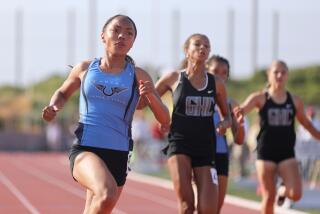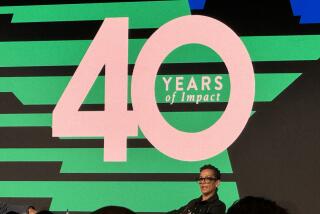Around : Cutbacks Threaten Carson Youth Cycling Program on Olympic Oval
- Share via
On a pass around the banked oval bicycle course, James Hardy, 11, zips his gear-less, brake-less bike up the steep bank and pedals madly past the other members of his team. Slipping back into the line, he grins good-naturedly at the boy he passed up.
Training for track bicycle racing in a youth program at Cal State Dominguez Hills, Hardy has developed strength, balance and endurance, but the program has had more than just physical benefits.
“When you come out here, you focus on one thing,” Hardy said. “That gets things off your back--especially your parents.”
Hardy is one of more than 400 youngsters ages 10 to 18 who learned competitive cycling through a free program offered at the Olympic Velodrome last year. But that group of riders will probably be the last, if adequate funding can’t be found, program officials said.
Since the cycling program’s inception in 1987, a grant from the Amateur Athletic Foundation has provided more than half its funding, with the university making up the difference.
The AAF was formed to administer $95.4 million it received as one-third of the profits from the 1984 Olympic Games. The foundation’s mission has been to fund youth sports programs in Southern California.
Over the last three years, the AAF has cut the program 20% each year. Last year’s grant was about $26,000, said Velodrome General Manager Nick Curl. The AAF has informed the university that the grant will continue to shrink by 20% each year until it is depleted.
Further cutbacks in the AAF grant may mean the end of the youth cycling program because the university may not be able to make up the difference, and alternate grants are hard to find, Curl said.
The Olympic Velodrome is also a leftover from the 1984 Games. The special track was built to host Olympic track cycling events, and afterward was left to the university to maintain.
Besides salaries for instructors and administrators, costs for the cycling program include providing helmets and $1,000 racing bikes.
During consecutive four-week sessions, the young boys and girls learn how to control the bikes and formulate racing strategy.
Hardy’s mother says the intensive training has paid off in other ways. “This has really helped him and motivated him,” Mia Hardy said.
Last year a team of 12 youngsters from the program won more than 25 medals at the U.S. Junior National Championships.
For many, Curl said, the track provides an after-school alternative to keep youths out of trouble. But for some of the participants, the pleasures are much simpler.
Kenyae Rollings, 15, said he loves to go fast on a track bicycle: “You feel the wind in your face.”
More to Read
Go beyond the scoreboard
Get the latest on L.A.'s teams in the daily Sports Report newsletter.
You may occasionally receive promotional content from the Los Angeles Times.







